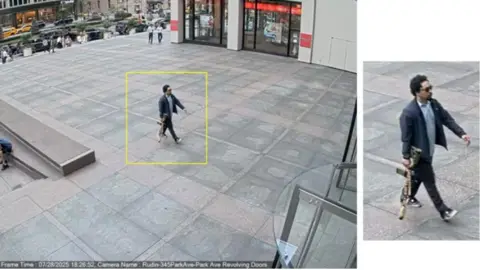On July 29, 2025, a tragic shooting incident unfolded in a Midtown Manhattan office building, claiming the lives of four individuals, including a New York City police officer, Didarul Islam. The horrific event began when the shooter, identified as Shane Devon Tamura, a 27-year-old originally from Las Vegas, entered the premises of the high-rise building located at 345 Park Avenue armed with an MR rifle. Witnesses reported that he prominently displayed the weapon before opening fire in the building’s crowded lobby and on an upper floor.
The chaos erupted around 6:30 PM Eastern Time, prompting panic among pedestrians and office workers alike as they sought refuge from the unfolding violence. Many individuals inside the building scrambled for safety, barricading themselves inside offices with furniture as gunfire rang out. The sheer unpredictability of the attack left even seasoned professionals in security and law enforcement rattled, underscoring the burgeoning issues of public safety in urban spaces.
Despite the chaotic context, it was reported that Tamura demonstrated an inexplicable restraint while passing by a woman in the elevator, allowing her to exit unharmed. After making his way to the 33rd floor, where Ruden Building Management operates, he fired upon others before ultimately taking his own life. It remains troublingly unclear what motivated Tamura’s actions, although investigators revealed that he had a documented history of mental health issues.
Among the deceased was Officer Islam, who had been on the force for three years. The news of his passing struck a chord throughout the New York community; police officials and city leaders gathered to commemorate the life of this dedicated officer. Islam was celebrated as a hero, having been in the line of duty and sacrificing his life to protect others. Born in Bangladesh, he had immigrated to the United States and was a devoted family man, leaving behind a wife and two children, with another child on the way.
In the aftermath of the attack, a larger investigation was launched, leading to a thorough examination of Tamura’s vehicle— a BMW he had double-parked outside the building. Law enforcement officials discovered multiple rounds of ammunition and a revolver inside the car; it was confirmed that the weaponry was legally owned by the suspect in the state of Nevada. The authorities were left scrambling to ascertain why Tamura traveled across states shortly before the shooting, including stops in Colorado, Nebraska, and Iowa.
Following the shooting, large sections of Midtown Manhattan were plunged into disarray, leading to significant disruptions in public transportation and local businesses. Emergency responders swarmed the area, conducting a floor-by-floor search of the building; the effort took hours, during which many office workers and civilians were evacuated under traumatic circumstances. Eyewitness accounts describe a scene of bewilderment and sheer terror as people fled, some even recounting the sound of gunfire echoing down the streets.
Mama Bouhenni, who worked at a nearby coffee shop, recalled seeing numerous individuals evacuating and holding their hands above their heads in an attempt to signal their innocent presence. This horrifying experience underscores the growing concerns about gun violence in public spaces in the United States, a topic that ignites passionate debates about national gun laws and public safety.
In the wake of this tragic shooting, communities across New York City have been left grappling with loss, anxiety, and a visceral need for safety reforms. As the investigation continues and families mourn, the pressing conversation around gun violence and law enforcement’s role in managing such threats intensifies. The incident at 345 Park Avenue has drawn attention not only to the immediate victims and their families but also to broader societal issues necessitating urgent discourse and action.












